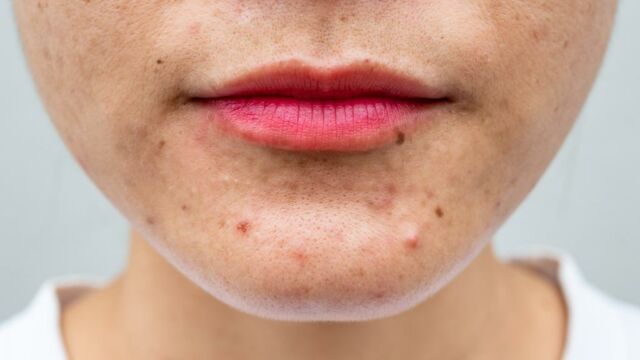Cystic acne: What it is and how to treat it

Cystic acne is the most painful and serious types of acne. Read on to find out what causes it and how we can treat it.
Acne breakouts come in a whole range of shapes and sizes. For the luckiest of us, a breakout is no more than a few pimples or blackheads. However, acne can be a much more serious skin condition for some, with cystic acne being the worst of them.
Discover our latest podcast
What is cystic acne?
Cystic acne is probably the most painful of all acne types, consisting of large nodules and cysts. Nodules are large lumps (usually over 5mm) that rest deep under the skin and are hard and painful to the touch. On the other hand, cysts are generally around 7mm in diameter, closer to the skin’s surface, and soft and filled with puss.
More under this adMore under this adCystic acne, like all other kinds, develops when sebum and skin cells clog up the pores, resulting in inflammation and bacteria overgrowth. While anyone can develop acne, cystic acne is most common in those with oily skin, teens, males and other adults with hormonal imbalances. This type of acne is also the most likely to cause scarring.
What causes cystic acne?
It is not known what causes some people to have cystic acne over others. However, a few common acne contributors and environmental conditions have been associated with this severe condition.
More under this adMore under this adHormones
Hormones and hormone imbalances are a significant cause of acne, including cystic acne. While progesterone and oestrogen can cause acne, the main culprit is androgens. An increase of androgens like testosterone are well known to cause an uptick in sebum production and acne.
Genetics
If your parents experienced cystic acne, your chances of developing it also increase. However, genetics are not often the sole contributing factor to any type of acne likely goes hand in hand with another.
More under this adMore under this adMedications
Some medications have acne as a side effect, increasing the chances of developing cystic acne.
Diet
Some studies have identified high glycemic index foods and dairy as contributing to hormone changes that trigger acne. However, studies on this topic often have mixed results, and no food should be treated as evil. If you believe some of these foods may be causing acne, try cutting back on them; but remember the key to health lies in moderation.
Environmental factors
Acne, and therefore cystic acne, is more common in tropical parts of the world. There is little evidence to suggest why, but this phenomenon has been observed in military personnel assigned to humid climates.
More under this adMore under this adHygiene habits
Acne is an inflammatory skin condition and is not caused by having ‘dirty’ skin. However, excessive cleansing and exfoliating can also damage the skin’s moisture barrier, creating irritation and further triggering acne.
How to treat cystic acne
Just as cystic acne is the most serious form of acne, it is also harder to treat. If you have cystic acne, it is best to consult a GP or dermatologist.
More under this adMore under this adTopical treatments for cystic acne
Less severe forms of cystic acne can often be treated with benzoyl peroxide products and retinoids. Benzoyl peroxides come in the forms of cleansers and creams and can be found in the pharmacy. Retinoids and retinoic acids such as adapalene or tretinoin come in the forms of creams and gels and may have to be prescribed by a health professional depending on where you live.
Birth control
Some women can be placed on birth control in order to ease their cystic acne. This is because some types of birth control can alter hormone production.
More under this adMore under this adAntibiotics and Accutane for cystic acne
More intense forms of cystic acne might be cause for a course of antibiotics or Accutane. This treatment is by prescription only and generally last up to six months. Antibiotics and Accutane should not be the first resort for treatment as they often come with many side effects.
Cortisone injections
If you have a particularly persistent and painful nodule, a dermatologist may provide a cortisone shot to help heal and reduce scarring.
More under this ad